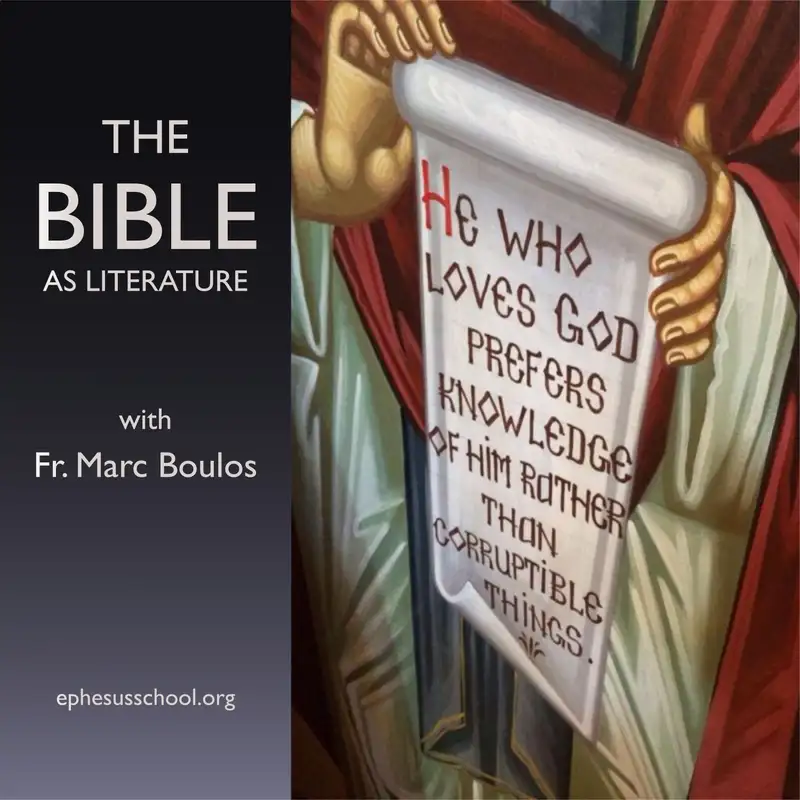
Crowd of Thorns
The thorns in Luke press and threaten. They are the self-referential swarm posing as a flock: the so-called “community” that gathers to its own voice, circling death, mistaking its stench for sweetness, even as it strangles the one bearing the seed.
These are the thorns.
But the roots are of another kind. They spring up from the seed itself. A daughter of Israel, fruit of the Master’s vine, afflicted for twelve years, who cannot live apart from him. She is not self-referential. She does not reach out to harm, nor to press her point, nor to insist upon herself. Though she is a daughter, she does not presume the right to cross the boundary set by what is sacred. She does not assume she is equal, much less above.
The threat that governs this boundary is the same one given to the priest in the wilderness:
“The outsider who draws near shall be put to death.” (Numbers 3:10, 38; 17:13).
It is the earth of creation itself under his Command. Life and death hinge on reference to him, which becomes submission. Absent reference, submission collapses into the “crowd of thorns”—the ʿedah swarming carrion, the lynch mob, the beloved neo-pagan “community.” The priest stands at the edge of that body: assigned to draw near, yet living under the same threat that borders the sanctuary. For proximity to what is holy is not possession of it. To approach on one’s own terms is to perish; to be drawn near in obedience is to live.
Pressure exposes the heart of this law. In Numbers, Balaam’s donkey pressed his foot against the wall because she saw what he could not. The pressure revealed the blindness of the man and the sight of the donkey. In Luke, the crowd presses upon Jesus, but he perceives what they cannot: the deliberate touch of the one who steps forward in faith. The same pressure that blinds the self-referential reveals the one who truly sees.
The thorns in Luke do not understand this law. They confuse nearness with ownership and approach with entitlement. Like the outsider who encroaches upon the altar, they rush forward without Command: pressing, consuming, swarming as if circling carrion. Their nearness is self-initiated; therefore, they take life.
But the daughter, like the biblical root sprung from the seed of the Sower, is drawn near by the Command. She approaches not to take but to receive. Unlike the thorns, she does not presume to cross the boundary by “right.” She draws near as an offering, not as an invader.
Now she stands in the center, and he is her circumference: her shield in the time of strife.
Hear, O daughter of Israel: draw near and see.
Do not be afraid.
The Lord is your Shepherd.
Do not be afraid.
The Lord is your Shepherd.
This week, I discuss Luke 8:43-45.
8:43 And a woman who had suffered from a discharge of blood for twelve years, and could not be healed by anyone, came [προσελθοῦσα / ק-ר-ב (qof-resh-bet)] up behind him and touched [ἥψατο / ק-ר-ב (qof-resh-bet)] the fringe of his cloak, and immediately her discharge of blood stopped. 45 And Jesus said, “Who is the one who touched [ἁψάμενός / ק-ר-ב (qof-resh-bet)] me?” And while they were all denying it, Peter said, “Master, the people are crowding and pressing [ἀποθλίβουσιν / ל-ח-ץ (lamed-ḥet-ṣade)] in on you.”
ק-ר-ב (qof-resh-bet) / ق-ر-ب (qāf-rāʾ-bāʾ )
ἅπτω (hapto)
“So you shall appoint Aaron and his sons that they may keep their priesthood, but the outsider who comes near [הקרב (ha-qareb)] shall be put to death.” (Numbers 3:10)
“But those who were to camp before the tabernacle eastward, before the tent of meeting toward the sunrise, were Moses and Aaron and his sons, performing the duties of the sanctuary for the obligation of the sons of Israel; but the outsider who comes near [הקרב (ha-qareb)] shall be put to death.” (Numbers 3:38)
“Everyone who comes near [הקרב (ha-qareb)], who comes near [הקרב (ha-qareb)] to the tabernacle of the Lord, must die. Are we to perish completely?” (Numbers 17:13)
In Numbers 3:10, 3:38, and 17:13, the Hebrew term הקרב (ha-qareb), from the root ק-ר-ב (qof-resh-bet), “to draw near, approach”, defines the law of approach that governs creation. The warning that “the outsider who draws near shall be put to death” does not protect tribe, identity, or privilege; it names the biblical principle of the open field itself.
The sanctuary, like God’s field, is an open expanse, not an enclosure. Yet, his Command governs its openness. Life exists only by reference to his instruction. His Command orders the heavens and the earth.
The priest stands at the edge of God’s field, where hearing and obedience hold the ground together. To cross without hearing is to move without reference, to “gather” for God’s judgment; to press, as the thorns do, devouring what cannot be possessed. The danger is not in being outside, but in stepping forward on one’s own terms, mistaking freedom for ownership. Even the appointed priest lives under this sentence. Closeness is not possession. The clearest lexical example of this in Luke is Judas:
“While he was still speaking, behold, a crowd came, and the one called Judas, one of the twelve, was preceding them; and he approached [ἤγγισεν engisen / ק-ר-ב] Jesus to kiss him.” (22:47)
Judas embodies unauthorized closeness, the New Testament fulfillment of הקרב (ha-qareb) in Numbers: the one who draws near and dies. Luke 22:47 is the clearest example of a self-referential disciple.
The tabernacle, like the open field, is the earth of creation under his Command: its boundaries invisible yet absolute, its center defined by hearing. To be drawn near by instruction is to live within the Lord’s circumference; to come near unbidden is to dissolve into dust. Life and death hinge upon reference within the open field of his Command.
προσέρχομαι (proserchomai)
“Then the daughters of Zelophehad, the son of Hepher, the son of Gilead, the son of Machir, the son of Manasseh, from the families of Manasseh the son of Joseph, came near [ותקרבנה (wattiqrabnah)]; and these are the names of his daughters: Mahlah, Noah, and Hoglah, and Milcah, and Tirzah.” (Numbers 27:1)
Here, ק-ר-ב (qof-resh-bet) indicates a rare instance of righteous petition. In Numbers, the daughters of Zelophehad step forward to the entrance of the tent: not to make a claim, but to submit. This reflects the function of the root itself, in which the one who draws near becomes interfunctional with the offering. Their nearness stands in sharp contrast to the ʿedah of Korah, who also “came near” (yiqrebu) and were swallowed by the earth. Where the rebellious qareb ends in death, the obedient qareb bears fruit: law and inheritance take root and blossom through submission. Their approach reveals the womb of nearness, rightly ordered by the Command—an approach that gives life rather than takes it.
“He said, ‘Relate to them in truth the story of Adam’s two sons, when they both offered [قَرَّبَا قُرْبَانًا (qarrabā qurbānan)] a sacrifice, and it was accepted from one of them but was not accepted from the other.’” (Qurʾan, Surat al-Māʾidah سورة المائدة “The Table Spread” 5:27)
In Surat al-Māʾidah 5:27, the verb قَرَّبَا قُرْبَانًا (qarrabā qurbānan), expresses the same law of approach found in Numbers (ק-ר-ב, qof-resh-bet). Both sons of Adam draw near through an offering, but only one is accepted, because nearness without reference to him, without reverence تَقْوَى (taqwā), becomes violence. The field of offering is open, but the Command governs its openness: life for the one rightly ordered, death for the one who presses forward on his own terms.
- (taqwā, wāw-qāf-yāʾ; to guard, protect, preserve, be wary; see Qurʾan 5:27)
ἀποθλίβω (apothlibo) / ל-ח-ץ (lamed-ḥet-ṣade)
The story of Balaam (בִּלְעָם / bilʿam) unfolds across Numbers 22-24 and concludes in Numbers 31, following a trajectory that mirrors the root sense of his name: “one who swallows” or “devours.”
In Numbers 22:25, the Hebrew verb לָחַץ (laḥaṣ) describes a scene of pressure born from obstruction. The donkey, seeing the angel of the Lord standing in the narrow way, presses Balaam’s foot against the wall. Something immovable impedes motion, producing contact, friction, and confinement. Yet the structure of perception is uneven. The donkey sees; Balaam does not. The pressure, though mechanical, is triggered by an unseen presence whose position in the path constricts movement. The donkey’s action is a response to what she perceives. Balaam acts out violence in reaction to what he does not see.
In Luke 8:45, the lexical correspondence ἀποθλίβω (apothlibo) renders a striking parallel. The crowd presses upon Jesus, hemming him in from all sides. The root θλίβω (thlibo), like לָחַץ (laḥaṣ), denotes pressing, squeezing, or constraining, and the prefix ἀπό (apo-) intensifies the sense of outward force. Yet here, perception is reversed. In Numbers, the donkey perceives the divine obstruction unseen by the man; in Luke, Jesus perceives the intentional touch unseen by the crowd. The Lukan “crowd of thorns” generates indiscriminate pressure, unaware of its own motion; within that same press, one woman presses deliberately, and Jesus, like the donkey, distinguishes her touch from all the rest.
Lexically, both verbs describe the closeness of bodies in a confined space, producing unavoidable contact, but the axis of awareness differs. In Numbers, sight moves upward, from the beast of burden to the locum tenens, yet Balaam remains blind. In Luke, sight moves downward, from the locum tenens, already walking on the same ground as the beast of burden, to the lowly woman, while the “crowd of thorns” remains blind. In one scene, pressure exposes blindness; in the other, it reveals discernment. The angel in Numbers corresponds functionally to the crowd in Luke, but not in a flattering way: both generate the constricting environment that elicits the act of pressing. Yet where Balaam’s donkey perceives and reacts, Jesus perceives and identifies.
Thus, the same lexical field: לָחַץ (laḥaṣ) / ἀποθλίβω (apothlibo), pressing through constraint, produces an inversion of sight: in Numbers, awareness belongs to the donkey; in Luke, to the one who will enter Jerusalem riding on a donkey. The movement from Balaam’s blindness to Jesus’ discernment completes the arc of perception across pressure, where his own constriction ultimately consumes the “swallower” who cannot see, as Jesus, pressed by the “crowd of thorns”, perceives clearly within it.
